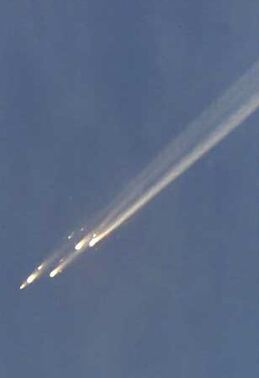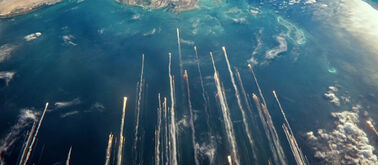
Mir (Russian: Мир, IPA: [ˈmʲir]; lit. Peace or World) was a space station that operated in low Earth orbit from 1986 to 2001, owned at first by the Soviet Union and then by Russia.
Mir was the first inhabited modular space station and was assembled in orbit from 1986 to 1996. It was the Russian predecessor to theInternational Space Station.
Mir being hit by a progress spacecraft and later being destroyed upon re-entry of the Earth's atmosphere most likely inspired the fate of the Tiangong Station in Gravity. What's also interesting about Mir is that it likely inspired the ISS fire after having caught on fire itself back in the 1980s.
Description[]
It had a greater mass than that of any previous spacecraft. It held the record for the largest artificial satellite orbiting the Earth until that record was surpassed by the International Space Station after Mir's deorbit on 21 March 2001. Mir served as a microgravity research laboratory in which crews conducted experiments in biology, human biology, physics, astronomy, meteorology and spacecraft systems in order to develop technologies required for the permanent occupation of space.
The station was the first consistently inhabited long-term research station in space and was operated by a series of long-duration crews. The Mir programme held the record for the longest uninterrupted human presence in space, at 3,644 days, until 23 October 2010 (when it was surpassed by the ISS), and it currently holds the record for the longest single human spaceflight, of Valeri Polyakov, at 437 days 18 hours. Mir was occupied for a total of twelve and a half years of its fifteen-year lifespan, having the capacity to support a resident crew of three, and larger crews for short-term visits.
Following the success of the Salyut programme, Mir represented the next stage in the Soviet Union's space station programme. The first module of the station, known as the core module or base block, was launched in 1986, and was followed by six further modules, all launched by Proton rockets (with the exception of the docking module). When complete, the station consisted of seven pressurised modules and several unpressurised components. Power was provided by several photovoltaic arrays mounted directly on the modules. The station was maintained at an orbit between 296 km (184 mi) and 421 km (262 mi) altitude and traveled at an average speed of 27,700 km/h (17,200 mph), completing 15.7 orbits per day.
The station was launched as part of the Soviet Union's manned spaceflight programme effort to maintain a long-term research outpost in space, and, following the collapse of the USSR, was operated by the new Russian Federal Space Agency (RKA). As a result, the vast majority of the station's crew were Soviet or Russian; however, through international collaborations, including the Intercosmos, Euromir and Shuttle-Mir programmes, the station was made accessible to astronauts from North America, several European nations and Japan. The cost of the Mir programme was estimated by former RKA General Director Yuri Koptev in 2001 as $4.2 billion over its lifetime (including development, assembly and orbital operation). The station was serviced by Soyuz spacecraft, Progress spacecraft and U.S. Space Shuttles, and was visited by astronauts and cosmonauts from 12 different nations.
Deorbit and Destruction[]

The remaining chunks of Mir burn up in the atmosphere.
Following the departure of Discovery on 8 June 1998, the EO-25 crew of Budarin and Musabayev were left aboard the station, carrying out materials experiments and the compiling of a station inventory. Meanwhile, back on Earth, Yuri Koptev, the director of the Roskosmos, announced on 2 July that, due to a lack of funding to keep Mir flying, the station would be deorbited in June 1999. The EO-26 crew of Gennady Padalka and Sergei Avdeyev arrived on 15 August in Soyuz TM-28, alongside physicist Yuri Baturin, who departed with the EO-25 crew on 25 August in Soyuz TM-27. The crew carried out two spacewalks, one inside Spektr to reseat some power cables and another outside to set up experiments delivered by Progress M-40, which also carried a large amount of propellant to begin alterations to Mir's orbit ready for the station's decommissioning. 20 November 1998 saw the launch of Zarya, the first module of the International Space Station, but delays to the new station's service module Zvezda had led to calls for Mir to be kept in orbit past 1999. Roskosmos, however, confirmed that it would not fund Mir past the set deorbit date.
The crew of EO-27, consisting of Viktor Afanasyev and Jean-Pierre Haigneré arrived in Soyuz TM-29 on 22 February 1999 alongside Ivan Bella, who returned to Earth with Padalka in Soyuz TM-28. The crew carried out three EVAs to retrieve experiments and deploy a prototype communications antenna on Sofora. Meanwhile, on 1 June it was announced that the deorbit of the station would be delayed by six months to allow time to seek alternative funding to keep the station operating. The rest of the expedition was spent preparing the station for its deorbit; a special analogue computer was installed and each of the modules, starting with the docking module, was mothballed in turn and sealed off. The crew loaded their results into Soyuz TM-29 and departed Mir on 28 August 1999, ending a run of continuous occupation of the station which had lasted for eight days short of ten years. The station's gyrodynes and main computer were shut down on 7 September, leaving Progress M-42 to control Mir and refine the station's orbital decay rate.

The Tiangong enters Earth's atmosphere.
Near the end of its life, there were plans for private interests to purchase Mir, possibly for use as the first orbital television/movie studio. The privately funded Soyuz TM-30 mission by MirCorp, launched on 4 April 2000, carried two crew members, Sergei Zalyotin and Aleksandr Kaleri, to the station for two months to do repair work with the hope of proving that the station could be made safe. This was, however, to be the last manned mission to Mir - while Russia was optimistic about Mir's future, its commitments to the International Space Station project left no funding to support the aging station.
Mir's deorbit was carried out in three stages. The first stage involved waiting for atmospheric drag to reduce the station's orbit to an average of 220 kilometres (140 mi). This began with the docking of Progress M1-5, a modified version of the Progress-M carrying 2.5 times more fuel in place of supplies. The second stage was the transfer of the station into a 165 × 220 km (103 × 137 mi) orbit. This was achieved with two burns of Progress M1-5's control engines at 00:32 UTC and 02:01 UTC on 23 March 2001. After a two-orbit pause, the third and final stage of Mir's deorbit began with the burn of Progress M1-5's control engines and main engine at 05:08 UTC, lasting a little over 22 minutes. Reentry into Earth's atmosphere (100 km/60 mi AMSL) of the 15-year-old space station occurred at 05:44 UTC near Nadi, Fiji. Major destruction of the station began around 05:52 UTC and most of the unburned fragments fell into the South Pacific Ocean around 06:00 UTC.